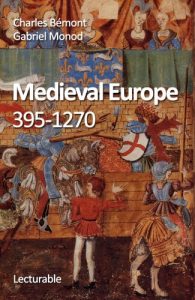"We have attempted to give to this volume a certain unity, not to make a simple chronological enumeration of events, but to group the details around the more important facts – the formation of the feudal system in succession to the Germanic invasions, the development of the Catholic Church, the strife of Christian Europe against the Muslim Orient, the struggle between the Papacy and the Empire leading to the fall of the German power, the formation of strong monarchies in France and in England. We have in particular given a large place to the rôle and to the history of the Church which dominates all this period, and which has been ordinarily so neglected in our schoolbooks, and have sought to make clear how France obtained in the thirteenth century a sort of political and intellectual hegemony in Europe. We hope those who read will understand what were the great ideas and directive tendencies which determined the historical evolution of the Middle Ages. We have always kept in mind in writing the conclusion to which we were advancing." - Charles Bémont & Gabriel Monod
Contents: The Roman Empire at the End of the Fourth Century. The Barbarians. The Germanic Invasions – The Vandals, The Visigoths, and the Huns (376-476). The Germanic Invasions – The Ostrogoths. The Germanic Invasions – The Barbarians in Gaul – Clovis. The Frankish Kingdom from 511 to 639. Institutions of Gaul after the Invasions. The Roman Empire of the East in the Sixth Century. The Last Invasions and the Papacy – The Lombards and Gregory the Great – The Anglo-Saxons and Monasticism. The Arabs – Mohammed. Arabian Empire – Conquests and Civilization. The Fainéant Kings – Foundation of the Carolingian Dynasty – Charlemagne. Empire of the Franks – Carolingian Customs and Institutions. The Carolingian Decadence, 814-888. The Last Carolingians – Invasions of the Saracens, Hungarians, and Norsemen – Origin of Feudalism. The Feudal System. Germany and Italy (888-1056). Emperor and Pope – Church Reform – Gregory VII. The Guelfs and Hohenstaufen – Alexander III. and Frederick I. Barbarossa. End of the Hohenstaufen – Victory of the Papacy over the Empire. The Christian and Mussulman Orient from the Seventh to the Eleventh Century. The Crusades. The Country Districts and Cities of France - Emancipation of Peasants and Bourgeois. French Royalty (987-1154). French Royalty (1154-1270). Institutions of Capetian Royalty. England from the Ninth to the Thirteenth Century. Continental Europe. The Roman Church in the Thirteenth Century. The Church and Heresies. Christian and Feudal Civilization – Instruction And Sciences – Literature And Arts – Worship. General Summary.
Contents: The Roman Empire at the End of the Fourth Century. The Barbarians. The Germanic Invasions – The Vandals, The Visigoths, and the Huns (376-476). The Germanic Invasions – The Ostrogoths. The Germanic Invasions – The Barbarians in Gaul – Clovis. The Frankish Kingdom from 511 to 639. Institutions of Gaul after the Invasions. The Roman Empire of the East in the Sixth Century. The Last Invasions and the Papacy – The Lombards and Gregory the Great – The Anglo-Saxons and Monasticism. The Arabs – Mohammed. Arabian Empire – Conquests and Civilization. The Fainéant Kings – Foundation of the Carolingian Dynasty – Charlemagne. Empire of the Franks – Carolingian Customs and Institutions. The Carolingian Decadence, 814-888. The Last Carolingians – Invasions of the Saracens, Hungarians, and Norsemen – Origin of Feudalism. The Feudal System. Germany and Italy (888-1056). Emperor and Pope – Church Reform – Gregory VII. The Guelfs and Hohenstaufen – Alexander III. and Frederick I. Barbarossa. End of the Hohenstaufen – Victory of the Papacy over the Empire. The Christian and Mussulman Orient from the Seventh to the Eleventh Century. The Crusades. The Country Districts and Cities of France - Emancipation of Peasants and Bourgeois. French Royalty (987-1154). French Royalty (1154-1270). Institutions of Capetian Royalty. England from the Ninth to the Thirteenth Century. Continental Europe. The Roman Church in the Thirteenth Century. The Church and Heresies. Christian and Feudal Civilization – Instruction And Sciences – Literature And Arts – Worship. General Summary.






